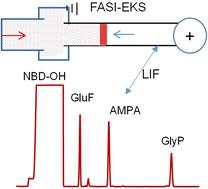当前位置:
X-MOL 学术
›
Anal. Methods
›
论文详情
Our official English website, www.x-mol.net, welcomes your feedback! (Note: you will need to create a separate account there.)
Sensitive detection of herbicide residues using field-amplified sample injection coupled with electrokinetic supercharging in flow-gated capillary electrophoresis
Analytical Methods ( IF 3.1 ) Pub Date : 2024-03-05 , DOI: 10.1039/d3ay01950k Ying Gong 1 , Maojun Gong 1
Analytical Methods ( IF 3.1 ) Pub Date : 2024-03-05 , DOI: 10.1039/d3ay01950k Ying Gong 1 , Maojun Gong 1
Affiliation

|
Residues of glyphosate (GlyP) and its major degradation product, aminomethylphosphonic acid (AMPA), widely exist in the water system and plant products and thus are also present in the bodies of animals and humans. Although no solid evidence has been obtained, the concern about the cancer risk of GlyP is persistent. The measurement of GlyP and AMPA in trace levels is often needed but lacks readily available analytical approaches with detection sensitivity, accuracy and speed. This study aims to develop a simple and robust technique for the sensitive detection of GlyP and AMPA residues in a surface water system with flow-gated capillary electrophoresis (CE). Experimentally, water samples were first fluorogenically derivatized with 4-fluoro-7-nitrobenzofurazan (NBD-F) in a low-conductivity buffer at room temperature, and the mixture was injected and concentrated in the capillary based on field-amplified sample injection (FASI) coupled with electrokinetic supercharging (EKS). This scheme included a step of sample buffer injection upon electroosmotic pumping, where negatively charged analytes were electrophoretically rejected, followed by automatic voltage reversal for FASI-EKS. The detection sensitivity was improved by 296, 444, and 861 times for glufosinate (GluF), AMPA, and GlyP, respectively. The proposed method was validated in terms of accuracy, precision, limits of detection (LODs), and linearity. The LODs were estimated to be 50.0 pM, 5.0 pM, and 10.0 pM for GluF, AMPA, and GlyP, respectively. Its application was demonstrated by measuring GluF and AMPA in water samples collected from a local water system. This study provides an effective approach for the online preconcentration of negatively charged analytes, thus enabling the sensitive detection of herbicide residues in water samples. The method can also be applied to analyze other samples, including biological fluids and plant products, upon appropriate sample preparation such as solid phase extraction of analytes.
中文翻译:

使用场放大进样结合流门毛细管电泳中的动电增压灵敏检测除草剂残留
草甘膦(GlyP)及其主要降解产物氨甲基膦酸(AMPA)的残留物广泛存在于水系统和植物产品中,因此也存在于动物和人类体内。尽管尚未获得确凿证据,但人们对 GlyP 致癌风险的担忧依然存在。通常需要测量痕量水平的 GlyP 和 AMPA,但缺乏具有检测灵敏度、准确性和速度的现成分析方法。本研究旨在开发一种简单而稳健的技术,通过流门毛细管电泳 (CE) 灵敏检测地表水系统中的 GlyP 和 AMPA 残留物。实验中,首先在室温下用 4-氟-7-硝基苯并呋喃 (NBD-F) 在低电导率缓冲液中对水样进行荧光衍生,然后基于场放大样品注射 (FASI) 将混合物注入毛细管中并浓缩。 )与动电增压(EKS)相结合。该方案包括电渗泵注入样品缓冲液的步骤,其中带负电的分析物被电泳剔除,然后自动反转 FASI-EKS 电压。草铵膦 (GluF)、AMPA 和 GlyP 的检测灵敏度分别提高了 296 倍、444 倍和 861 倍。所提出的方法在准确性、精密度、检测限 (LOD) 和线性方面得到了验证。 GluF、AMPA 和 GlyP 的 LOD 估计分别为 50.0 pM、5.0 pM 和 10.0 pM。通过测量从当地水系统收集的水样中的 GluF 和 AMPA 来证明其应用。这项研究为带负电分析物的在线富集提供了一种有效的方法,从而能够灵敏地检测水样中的除草剂残留。在适当的样品制备(例如分析物的固相萃取)后,该方法还可用于分析其他样品,包括生物液体和植物产品。
更新日期:2024-03-05
中文翻译:

使用场放大进样结合流门毛细管电泳中的动电增压灵敏检测除草剂残留
草甘膦(GlyP)及其主要降解产物氨甲基膦酸(AMPA)的残留物广泛存在于水系统和植物产品中,因此也存在于动物和人类体内。尽管尚未获得确凿证据,但人们对 GlyP 致癌风险的担忧依然存在。通常需要测量痕量水平的 GlyP 和 AMPA,但缺乏具有检测灵敏度、准确性和速度的现成分析方法。本研究旨在开发一种简单而稳健的技术,通过流门毛细管电泳 (CE) 灵敏检测地表水系统中的 GlyP 和 AMPA 残留物。实验中,首先在室温下用 4-氟-7-硝基苯并呋喃 (NBD-F) 在低电导率缓冲液中对水样进行荧光衍生,然后基于场放大样品注射 (FASI) 将混合物注入毛细管中并浓缩。 )与动电增压(EKS)相结合。该方案包括电渗泵注入样品缓冲液的步骤,其中带负电的分析物被电泳剔除,然后自动反转 FASI-EKS 电压。草铵膦 (GluF)、AMPA 和 GlyP 的检测灵敏度分别提高了 296 倍、444 倍和 861 倍。所提出的方法在准确性、精密度、检测限 (LOD) 和线性方面得到了验证。 GluF、AMPA 和 GlyP 的 LOD 估计分别为 50.0 pM、5.0 pM 和 10.0 pM。通过测量从当地水系统收集的水样中的 GluF 和 AMPA 来证明其应用。这项研究为带负电分析物的在线富集提供了一种有效的方法,从而能够灵敏地检测水样中的除草剂残留。在适当的样品制备(例如分析物的固相萃取)后,该方法还可用于分析其他样品,包括生物液体和植物产品。



























 京公网安备 11010802027423号
京公网安备 11010802027423号